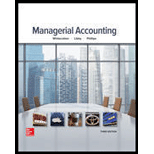
Concept explainers
Concept introduction:
Cost Volume Profit (CVP) Analysis:
The Cost Volume Profit analysis is the analysis of the relation between cost, volume, and profit of a product. It analyzes the cost and profits at the different level of production, in order to determine the breakeven point and required the level of sales to earn the desired profit.
Contribution margin means the margin that is left with the company after recovering variable cost out of revenue earned by selling smart phones. The formula for contribution margin is as follows:
Contribution margin = Sales - Variable cost.
Similarly contribution margin ratio = Contribution/sales
To indicate:
The Calculation of Total Contribution margin, Contribution margin per unit, and Contribution margin ratio
Want to see the full answer?
Check out a sample textbook solution
Chapter 5 Solutions
Managerial Accounting
- Boca Inc. Balance Sheets December 31 Assets Cash Accounts Receivable Inventory Prepaid Expenses 2022 2021 110,800 48,400 38,000 87,800 112,500 102,850 26,000 28,400 Long-term investments 109,000 138,000 Plant Assets 397,000 242,500 Accumulated depreciation 50,000 52,000 Total 743,300 595.950 Liabilities and Stockholders' Equity Accounts Payable 72,000 67,300 Accrued Expenses Payable 13,500 21,000 Dividends Payable 3,000 Bonds Payable Common Stock 170,000 146,000 262,000 175,000 Retained Earnings Total 222.800 186.650 243,300 595.950 Additional Information: 1. Old plant assets having an original cost of $57,500 and accumulated depreciation of $48,500 were sold for $1,500 cash. 2. A new plant asset was purchased directly in exchange for common stock valued at $42,000. 3. New bonds were issued at par for $60,000. 4. 2022 Net income was $154,480. 5. A $1,000 prior period adjustment was recorded in 2021 correcting an understatement of depreciation in 2019. The 2021 balance sheet is…arrow_forwardPlease explain the solution to this general accounting problem with accurate explanations.arrow_forwardNathan Industries applies overhead using a normal costing approach based on direct labor-hours. The budgeted factory overhead was $480,000, and the budgeted direct labor-hours were 12,000. The actual factory overhead was $492,500, and the actual direct labor-hours were 12,750. How much overhead would be applied to production?arrow_forward
- Please provide the solution to this general accounting question using proper accounting principles.arrow_forwardAfter the year-end adjustment, what is the net realizable value of accounts receivable?arrow_forwardVantage Components, Inc. determined at the beginning of the year that estimated overhead costs would be $650,000, and the estimated allocation base would be 65,000 direct labor hours. By the end of the year, actual overhead costs totaled $698,000, and actual direct labor hours worked were 68,500. What was the dollar amount of underallocated or overallocated manufacturing overhead?arrow_forward
- Principles of Accounting Volume 2AccountingISBN:9781947172609Author:OpenStaxPublisher:OpenStax College
